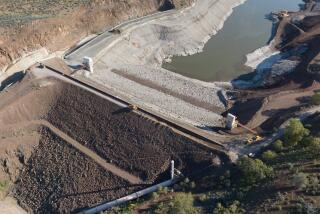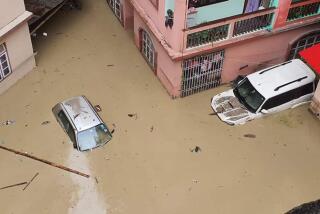Soviet-Backed Project in India : Village Fights Plans to Dam Holy River
TEHRI GARHWAL, India — People of this remote hill town are using every weapon from lawsuits to black magic in their fight to halt construction of a Soviet-financed dam on a holy river.
They say the dam, planned as South Asia’s largest hydroelectric project, will displace 70,000 people near the Chinese frontier and would threaten 200,000 more in the Himalayan foothills if it gave way. Geologists say a risk exists of the dam bursting because it is in an unstable seismic zone and the surrounding rock formation is weak.
“The dam should not go up because it is risk-laden,” said Birendra Saklani, head of the Tehri Dam Opposition Agitation Committee. “God forbid if it bursts, as it may. Thousands of people will die.”
Saklani’s group has spent 14 years fighting the giant hydroelectric project with protests and legal actions. A suit filed in 1985 now is before the Supreme Court.
Financial and technical problems have plagued the dam.
Soviet money and technicians became involved after Kremlin leader Mikhail S. Gorbachev visited India in November and pledged 20 billion rupees ($1.53 billion) to Prime Minister Rajiv Gandhi’s government, most of which will go to the dam.
Hindu Prayer Rituals
Tehri once was a royal state, and Mati Shah, the 84-year-old former queen, is trying to block the project with complicated Hindu prayer rituals called pujas that often involve black magic.
“We will see who is powerful, mighty Russia or our deity,” she said.
The government has appropriated her 250-year-old palace as a project office for the rock-filled dam.
Objections do not appear to have deterred the Soviets. A formal agreement for technical help was announced June 22 in Moscow.
More than 500 Soviet technicians are expected to arrive with their families later this year. Plans are for such specialists to serve in rotation until the project is finished in 1996.
The dam on the Bhagirathi, which is considered a holy river and is named for a Hindu saint, is intended as the largest hydroelectric project in South Asia, with an ultimate capacity of 2,400 megawatts.
It is being built in the northern state of Uttar Pradesh, 77 miles from the Chinese border.
Residents also fret that a Soviet presence could exacerbate India’s long-running border dispute with China.
Such worries increased because of visits since March by 22 Soviet experts who conducted extensive aerial surveys.
“We know the Russians are India’s friends, but their presence here can become a security risk,” Saklani said.
Loss of Homes
Central to his complaint is the fact that the ancestral homes of 70,000 villagers would be lost to the dam’s reservoir. The government has offered new home sites, but only a few people have accepted.
According to the project report, the reservoir will cover the town of Tehri, where 30,000 people live, and 25 nearby villages, and its waters will affect parts of 72 hillside hamlets.
At particular risk if the dam should burst are Hardwar and Rishikesh, on the Ganges River. The Bhagirathi flows into the Ganges.
About 150,000 people live in the two towns, and 10,000 to 15,000 Hindu pilgrims usually are stopping there at any given time en route to shrines in the Himalayas.
Even the Indian government said last March that some risks were involved with the dam. Commenting on an environmental report, Environment and Forests Minister Bhajan Lal told Parliament in a written statement:
“Some segments of the reservoir slopes are unstable. The project is located in a highly sensitive seismic zone, and the failure of the dam or the hill slopes would threaten the entire population of Rishikesh and Hardwar.”
The report did not recommend abandoning the project, however, and Gandhi’s government said helping meet the growing need for electricity is worth the risk.
More to Read
Sign up for Essential California
The most important California stories and recommendations in your inbox every morning.
You may occasionally receive promotional content from the Los Angeles Times.










